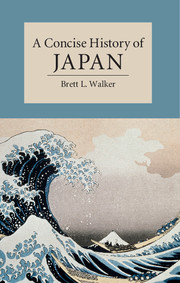Book contents
- Frontmatter
- Dedication
- Contents
- List of Illustrations
- List of Maps
- Preface
- Chronology
- Introduction
- 1 The Birth of the Yamato State, 14,500 bce – 710 ce
- 2 The Courtly Age, 710–1185
- 3 The Rise of Samurai Rule, 1185–1336
- 4 Medieval Japan and the Warring States Period, 1336–1573
- 5 Japan’s Encounter with Europe, 1543–1640
- 6 Unifying the Realm, 1560–1603
- 7 Early Modern Japan, 1600–1800
- 8 The Rise of Imperial Nationalism, 1770–1854
- 9 Meiji Enlightenment, 1868–1912
- 10 Meiji’s Discontents, 1868–1920
- 11 The Birth of Japan’s Imperial State, 1800–1910
- 12 Empire and Imperial Democracy, 1905–1931
- 13 The Pacific War, 1931–1945
- 14 Japan’s Post-War History, 1945–Present
- 15 Natural Disasters and the Edge of History
- Glossary
- Further Reading
- Index
2 - The Courtly Age, 710–1185
Published online by Cambridge University Press: 05 March 2015
- Frontmatter
- Dedication
- Contents
- List of Illustrations
- List of Maps
- Preface
- Chronology
- Introduction
- 1 The Birth of the Yamato State, 14,500 bce – 710 ce
- 2 The Courtly Age, 710–1185
- 3 The Rise of Samurai Rule, 1185–1336
- 4 Medieval Japan and the Warring States Period, 1336–1573
- 5 Japan’s Encounter with Europe, 1543–1640
- 6 Unifying the Realm, 1560–1603
- 7 Early Modern Japan, 1600–1800
- 8 The Rise of Imperial Nationalism, 1770–1854
- 9 Meiji Enlightenment, 1868–1912
- 10 Meiji’s Discontents, 1868–1920
- 11 The Birth of Japan’s Imperial State, 1800–1910
- 12 Empire and Imperial Democracy, 1905–1931
- 13 The Pacific War, 1931–1945
- 14 Japan’s Post-War History, 1945–Present
- 15 Natural Disasters and the Edge of History
- Glossary
- Further Reading
- Index
Summary
With the emergence of the Yamato state and the advent of its imperial line, Japan entered the Nara (710–94) and Heian periods (794–1185). The fledgling imperial regime’s history shares much in common with other nascent monarchies around the world: frontier war and conquest, implementation of judicial and administrative bureaucracies, capital planning, elite monopolization of surplus, and the flowering of a rarefied court culture. In Japan, this courtly age served as the domain of the fictional Prince Genji, a literary creation of writer Murasaki Shikibu (c.978–1014). A fictional master of his artful age, Prince Genji writes exquisitely learned poetry, romances such tragic beauties as Yûgao (Evening Face), croons with acquaintances about singing warblers and chirping insects, and moves through the social intricacies of the Heian court with dexterous grace. His mood is perennially sensitive and melancholic, always touched by the sadness of this fleeting world: a Buddhist aesthetic inspired by the transience of things. Importantly, the natural aesthetic of the Heian period, particularly as preserved in poetry, shaped enduring Japanese attitudes towards the natural world.
The development of Japan’s courtly age began with the Nara court’s conquest of the Emishi, a tribe of hunter-gatherers in the northeastern section of the archipelago, people largely removed from the Chinese-inspired changes that had swept Japan since the fourth century. They are best described as Jômon remnants: people who stood outside the ritsuryô (penal and administrative) codes that incrementally defined life in Japan’s core provinces by the seventh century. The Nara court constructed an elaborate Buddhist theocracy and Chinese-style administrative bureaucracy, which it relied upon for managing the affairs of state. The Heavenly Sovereigns, following their earlier Yamato trajectory, developed into chief priests and imperial ‘living gods’, who shared, at least in the pages of the Kojiki (Record of ancient matters, 712), divine ancestors with the Sun Goddess. The Kojiki brushes over genealogical discontinuities among Japan’s emperors, which was its principal purpose in narrating the land’s creation myth. Other eighth-century sources, such as the Nihon shoki (Chronicles of Japan, 720), resemble Chinese dynastic histories, drafting a record of events from the advent of the Yamato emperors forward. Dynastic genealogies proved important because they, along with the ritsuryô codes, cemented and legitimized political power. By the end of the eighth century, Heian culture had become an amalgam of elements from Buddhist theocracy and ritsuryô governance.
- Type
- Chapter
- Information
- A Concise History of Japan , pp. 26 - 43Publisher: Cambridge University PressPrint publication year: 2015



